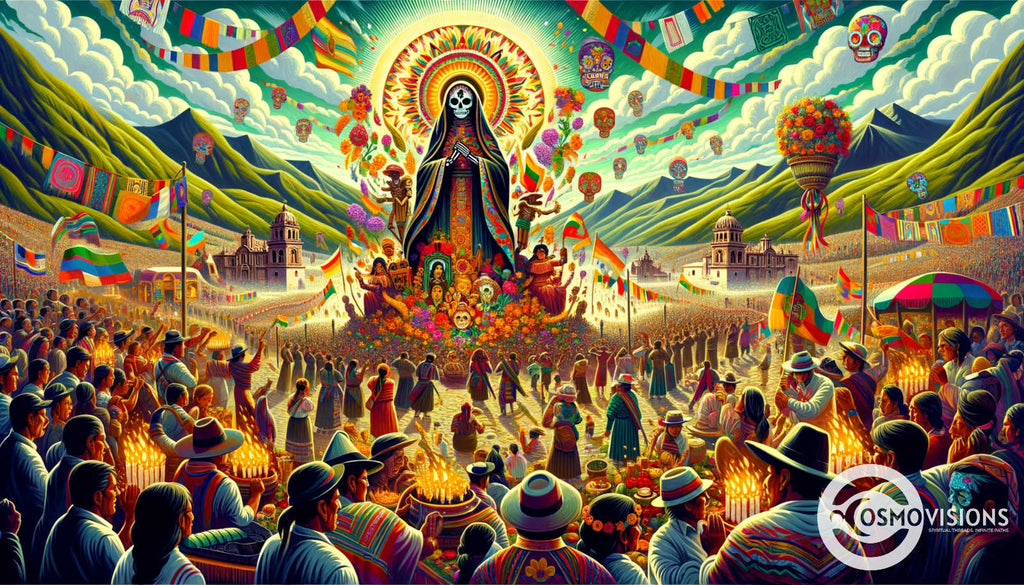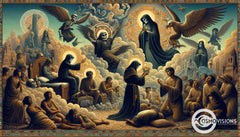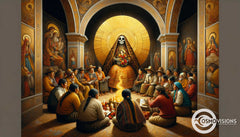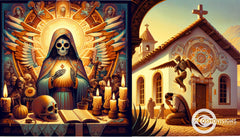Exploring the Tradition of Celebrating Santa Muerte
Posted by Luciano Martucci

In a world brimming with diverse cultures and spiritual beliefs, it's easy to feel curious about the unusual and mystical traditions that thrive on its fringes. Imagine encountering an enigmatic figure often shadowed within mainstream dialogue, yet deeply revered by millions; an entity embodying both the benevolence of protection and the solemnity of life's end.
This is La Santa Muerte, a potent symbol in many communities seeking solace beyond conventional religious practices.
La Santa Muerte captivates hearts as a folk saint who listens when others turn away. Wrapped in her allure are tales of comfort for those feeling left behind by society or traditional religion.
Our article unravels these rich tapestries surrounding La Santa Muerte culture—her history, her followers' devotion in Mexico City and beyond, and why some view her as their guard against adversity.
Delve into this uncharted realm where faith defies boundaries; let’s explore how La Santa Muerte's remarkable saga enfolds support for the people. Ready to unveil secrets? Continue reading—we promise intrigue at every turn.
The Historical Significance and Global Influence of La Santa Muerte
La Santa Muerte is a figure deeply embedded in the rich tapestry of Mexican culture, emerges from the confluence of indigenous beliefs and Spanish colonial Catholicism, marking a unique synthesis that began when the indigenous populations venerated the deities of Mictlān, the place ruled by Mictlantecuhtli and Mictecacíhuatl.
This reverence, particularly pronounced among the Aztecs who worshipped Mictecacihuatl, the queen of Mictlān — the underworld in Aztec mythology—evolved rather than diminished upon encountering Spanish conquistadors and their Catholic Christianity, absorbing European religious traditions to form the entity now known as La Santa Muerte.
Unlike traditional Catholic saints, La Santa Muerte is not recognized by the mainstream Catholic Church, yet she is depicted with a compassionate and protective aura, echoing the motherly figures revered within Hispanic communities. Her emergence as a folk saint, accompanied by the help offered to those seeking support or comfort, has significantly contributed to her contemporary cultural role, underlining her importance within popular Mexican spirituality.
Devotees celebrate her through various rituals that underscore the diverse aspects she embodies, from her protective nature to her role as a guide through difficult circumstances.
La Santa Muerte's influence extends beyond Mexico's borders, captivating a global audience with her skeletal imagery reminiscent of La Catrina from Dia de Muertos and combining elements of the Virgin Mary with the European Grim Reaper.
This blend of indigenous Mesoamerican beliefs and European influences resonates widely, leading to an expanded recognition and worship. She is venerated not just as death personified but as a protective force for those seeking comfort at life's margins, including LGBTQ communities, marginalized groups, and even those involved with law enforcement or drug cartels.
Her diverse iconography, featuring robes of various colors representing different aspects such as love, justice, and financial well-being, highlights her appeal across different walks of life.
La Santa Muerte's global presence, challenging traditional religious syncretism and intertwining with folk Catholicism, defies simple categorization, illustrating her role as a significant spiritual figure who transcends cultural and geographical boundaries.
La Santa Muerte in Mexican Folklore
While La Santa Muerte has a global presence, her roots go deep into Mexican folklore where she holds a profound place. In art and story, this skeletal figure grips a globe or scale, symbolizing her impartial reach to all corners of human existence.
Devotees honor her through altars decorated with flowers, candles, offerings of tobacco or hard alcohol, and they pray feverishly for protection or blessings. La Santa Muerte's following includes people from all walks of life; some see her as an avenger or protector while others turn to her in times of illness or despair.
In Mexico's vibrant cultural tapestry, La Santa Muerte stands out with an ambiguous reputation—both feared and loved. Here lies a paradox: while some see her as dangerous due to associations with drug trafficking and crime, countless others seek comfort in La Flaquita's embrace.
They find refuge from problems that riddle their lives, offering prayers to Saint Death for protection and favor without judgment—a guardian who understands life’s darker side as intimately as its light.

La Santa Muerte's Significance in Modern Mexican Society
In a modern world filled with uncertainty and challenges, La Santa Muerte has emerged as a beacon of hope and security for many who feel marginalized. Her role as a protector and guide has become increasingly relevant, addressing the spiritual needs of those seeking comfort and solace in tumultuous times. Her unique power to offer relief and dignity in the face of suffering highlights her significance as a figure of reverence and guidance.
The Enduring Appeal and Contemporary Worship of La Santa Muerte
The veneration of La Santa Muerte, after being hidden for several years, it has once again flourished in the Mexican barrios, appealing to those who find themselves at odds with orthodox Christian doctrines. Her followers, coming from diverse backgrounds, engage in rituals and expressions of devotion that reflect her importance in Mexican spirituality.
This evolving veneration underscores the changing spiritual landscape of Mexico, where La Santa Muerte is revered not only as a symbol of death but also as a protector and provider, offering an alternative source of guidance and protection.
La Santa Muerte's association with healing and protection is symbolically represented by the color mauve in Mexican folk spirituality, underscoring her role as a powerful ally in times of need. Her influence, transcending religious boundaries, has cemented her position as a pivotal figure in the cultural and spiritual lives of her devotees.
As a source of comfort and solace, La Santa Muerte continues to provide security and peace, embodying the resilience and adaptability of belief systems that have flourished over centuries. This enduring legacy highlights her significance not just within the realm of spirituality but also as a cultural icon that represents the complexities and nuances of Mexican society.
This duality is essential to understanding how deeply ingrained she is within Mexican spirituality, transcending mere superstition to become part of daily life for millions seeking guidance and protection outside conventional channels.
Death Goes Public
Public celebrations and processions dedicated to La Santa Muerte have become increasingly visible in Mexico, an indication of the folk saint's rising popularity. Followers openly display their devotion by wearing jewelry depicting her image, and organizing public events where they gather to honor her.
This open expression of reverence towards La Santa Muerte highlights the expansion of her influence beyond private altars into communal spaces, making death a more visible part of public life than ever before.
As La Santa Muerte gains momentum as a prominent figure in Mexican folk Catholicism, she continues to challenge traditional perceptions of death and spirituality. Devotees' willingness to publicly express their faith reflects a growing acceptance and integration of this controversial deity within societal norms.

La Santa Muerte and the Day of the Dead
While both La Santa Muerte and the Day of the Dead are related to death and Mexican culture, they have distinct beliefs, practices, and significance. The interplay of these two traditions during Dia de los Muertos showcases the complex cultural tapestry of Mexico and its spiritual practices.
Similarities and Differences
The Day of the Dead and La Santa Muerte both involve reverence for death, but their historical origins and cultural significance differ. The Day of the Dead is a traditional Mexican festival with pre-Columbian roots, celebrated nationwide as a way to honor deceased ancestors.
While both are significant in Mexican culture, they convey distinct religious and cultural meanings.
Despite both honoring death, La Santa Muerte represents an alternative veneration that stands apart from the more widespread celebration of Dia de los Muertos throughout Mexico. This distinction reflects varying cultural practices within Mexican society — one grounded in ancient traditions and communal celebrations (Dia de los Muertos), while the other emerged as a new, but increasingly popular and rapidly expanding religious movement.
The Interplay of Cultures on Dia de los Muertos
The interplay of cultures on Dia de los Muertos is a fascinating blend of indigenous Mesoamerican traditions with Catholic rituals brought by the Spanish conquistadores. This unique fusion showcases the syncretism between pre-Hispanic beliefs and European practices, resulting in vibrant and colorful festivities that honor deceased loved ones.
With offerings of marigolds, sugar skulls, and pan de muerto, families create altars to welcome back the spirits during this time of remembrance.
In addition to these customs, La Santa Muerte religion's influence can be seen during Dia de los Muertos celebrations. The veneration of La Santa Muerte demonstrates how diverse belief systems have intertwined within Mexican culture over generations.

Comparison between La Santa Muerte and Day of the Dead Celebrations
While the tradition of La Santa Muerte often faces opposition and misunderstanding, it's essential to highlight its distinct characteristics by contrasting it with the more widely recognized Day of the Dead celebrations. Both traditions are deeply rooted in Mexican culture but serve different purposes and origins.
|
La Santa Muerte Celebration |
Day of the Dead Celebration |
|
La Santa Muerte is a folk saint embodying death. |
Day of the Dead honors deceased loved ones. |
|
Practitioners often seek protection or favors. |
Families offer food and memories to the dead. |
|
Has become prominent in the last few decades. |
Traces back centuries, combining Indigenous and Catholic practices. |
|
Iconography features a skeletal female figure. |
Includes ofrendas and colorful calaveras (skulls). |
|
Worship can be solitary or within a group. |
Celebrated communally, especially in cemeteries. |
|
Seen as a powerful and somewhat controversial figure. |
Widely accepted, family-oriented tradition. |
|
No specific dates, veneration occurs year-round. |
Celebrated from October 31 to November 2. |
|
Involves personal altars and ritual offerings. |
Features altars with marigolds, photos, and mementos. |
|
Often associated with those living on the margins of society. |
Inclusive celebration, embracing all social classes. |
|
Veneration includes prayers, offerings, and dedications. |
Includes making ofrendas and visiting gravesites. |






















